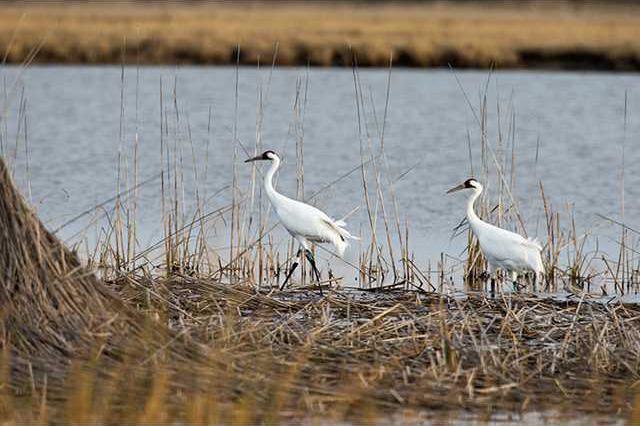They are migrating as we speak. They appear in bunches and groups of varying numbers. They glide in on huge white wings with black tips. They have been confused with pelicans which also have huge white wings with black tips. Snow geese also have white wings with black tips. The long neck of the cranes separates it from the small snow goose and the pelican with the big mouth. Their legs stream out behind them in flight. Sandhill Cranes are similar in size and shape and flight — but they are gray birds. The Whoopers are moving from summer quarters in Wood Buffalo National Park in Alberta. Another group is being groomed to nest naturally in central Wisconsin. They lay a couple of eggs on the ground and usually only one survives. They are on the move to get to Rockport, Texas and crash in the Aransas National Wildlife Refuge and surrounding area.
We in Kansas think the Cheyenne Bottoms and Quivira Refuge are the only places they stop on this trip. Not so fast—the Salt Plains National Wildlife Refuge in Oklahoma is a motel for about 75 percent of the total population. They take great pride in housing these birds for a short time on the turn-around. Breakfast is free and ample. They seem to relish blue crabs in Texas but will survive very well on frogs, fish, rodents, crayfish, and grain such as wheat, barley, and corn. Recent reports indicate that Hurricane Harvey didn’t do any significant damage to the refuge as it did to the town of Rockport.
There has been some controversy associated with these birds. One item is the cost involved. According to several sources, the FWS spends about $6 million annually on “Whooping Crane Recovery.” It is estimated that it requires 10 years to accumulate 100 birds. That tallies out at approximately $12,000 per bird per year. In October of 2016, an 18-year-old kid shot and killed two birds while goose hunting in Jefferson County, Texas. He was fined $25,850. He had to do 200 hours of community service. He lost all his firearms. He has a five-year suspension of a hunting license in all 50 states. He didn’t go to prison. There have been birds shot in Kansas and other states with variable outcomes. I personally am still galled at the judge in Wichita that let the poachers from Texas recover a lot of money because “deer have no value” since they can’t be bought and sold. He ought to examine the cost of Whooping Cranes. George Bush appointed him. He wouldn’t talk to me.
The gene pool of the Whoopers is also suspect. There may not be enough diversity (that word gets a lot of play recently) to build strong birds. It seems that the numbers are increasing, and hopefully the Wisconsin clan will spread genetics in different directions. We can all recall the video of the fellow hopping around in a crane uniform and then flying an ultralight aircraft with birds in tow. Lots of energy has gone into saving these birds.
I think these birds cause some difficulty. When they are on the refuge, the Cheyenne Bottoms and Quivira shut down all hunting. We have lost a lot of hunting days due to these birds. Everyone who hunts Sandhill Cranes is required to take a test to get a license. It is amazing how gray Sandhills change color in bright sunlight. Same for Whoopers. Know your birds — it isn’t cheap if you make a mistake. In my opinion, the birds are worth the cost. When they are high in the sky in a circling formation, calling to each other and gradually losing altitude with the sun on their wings (it is like an X-ray when the sun is behind them—you can see the wing bones), it is genuinely humbling and intense to just watch and listen as they land ever so lightly and immediately begin to forage. Someone got it right when He made these birds.
Doctor Dan Witt is a retired physician and nature enthusiast.





